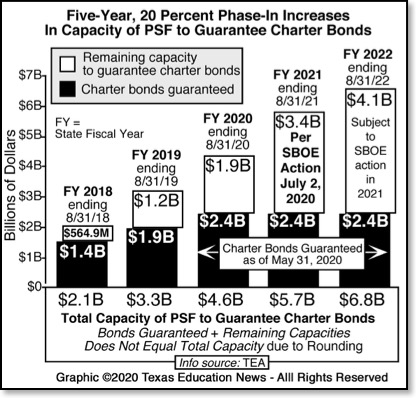Opponents Cited Pandemic’s Unknown Impact on Charters
Split Board Okays Upping PSF’s Capacity
To Guarantee Charter School Bonds
The most contentious matter considered by the SBOE resulted in the board, by a split vote, approving allowing the capacity of the Permanent School Fund (PSF) to guarantee charter school bonds to automatically increase by 20 percent for the upcoming 2021 fiscal year that begins Sept. 1, 2020.
This is the fourth year of a five-year phase-in schedule of 20 percent increases in the PSF’s capacity to guarantee charter bonds under terms of 2017 legislation. The board in 2021 will decide whether to allow the fifth and final 20 percent automatic increase to occur. See graphic below.

As reflected in the graphic, the board’s approval at this month’s meeting is projected to increase the unused charter bond guaranteeing capacity of the PSF from the current $1.9 billion to $3.4 billion for the upcoming fiscal year.
Failed on a 5-9 Vote
A motion by Ruben Cortez Jr., D-Brownsville, to use the board’s authority in state law to block the increases in the PSF’s charter bond guarantee capacity failed by a 5-9 vote.
Cortez said that increasing the PSF’s charter bond guarantee capacity should be rejected due to concerns that the pandemic would result in declining enrollments as students don’t return to their schools. Charters (unlike ISDs) depend on student attendance as their only source of state funding. Reduced state funding could hamper a charter’s ability to pay off its bonds, Cortez predicted — adding that reduced attendance would diminish the need for charters to build bond-funded brick-and-mortar facilities.
Supporters of the 20 percent capacity increase expressed doubts that pandemic-related concerns are among the reasons in state law that can be used by the SBOE to block the increases from automatically taking effect. TEA staff said the major bond ratings agencies have not yet raised concerns over the impact of the pandemic on the ability of charters to make their bond payments.
Higher Bar
Supporters also noted that charters (unlike ISDs) have a higher bar to pass in terms of demonstrating they are financially stable and are not likely to default on a bond.
Supporters also noted that charters (unlike ISDs) pay into a special reserve fund (currently totaling $35 million) that will be tapped into first (without having to touch the PSF’s principal) in case a charter does default on a bond — and that the state has first dibs on any real estate and other assets owned by charters that can be seized to pay off debts of charters that default.
SBOE member Ken Mercer, R-San Antonio, cited data from the state’s charter schools association reflecting that PSF bond guarantees, due to lower bond interest payments, are collectively saving the charters $12 million a year, money he said that is being put into the classroom.
Reports
The board, as a separate item, approved PSF related reports reflecting that as of Aug. 31, 2019 (the latest data available), the PSF was guaranteeing a total of:
- 49 charter bond issues totaling about $1.9 billion for 15 charters, with the largest bonds guaranteed for: 1) IDEA Academy ($588.3 million), 2) Harmony Public Schools ($296.7 million) and 3) KIPP Texas ($282.6 million).
- 3,297 ISD bond issues totaling $82.5 billion for 847 ISDs — leaving about $34.8 billion unused in the PSF’s $117.3 billion total capacity to guarantee ISD bonds, with the largest total bond amounts guaranteed for: 1) Cypress-Fairbanks ISD ($2.59 billion), 2) Dallas ISD ($2.47 billion), 3) Houston ISD ($2.39 billion) and 4) Northside [Bexar County] ISD ($2.17 billion).
As ISD and charter PSF bonds are paid off, the remaining capacity of the fund to guarantee additional bonds increases.
Click here for a comprehensive summary of the status of the PSF bond guarantee program as of Aug. 31, 2019.